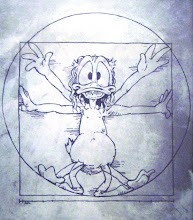Way back in time, when I was a freshman in college (for the first time) and still tinkering with the idea that I might want to become a doctor, I took a biology course that basically focused on the dissection of various critters. This was merely an extension of my childhood activities, as I grew up in a family of hunting and fishing guides in Wyoming, so I had cut up just about every single animal I got my hands on. Anyway, the climax of the course was the vivisection of a turtle. After the basic inspection and harmless preliminary tests on the turtle, we drilled a 2" hole through the underside of its shell, and watched its heart beating. And watched its heart rate slow. And watched its heart stop completely.
Then, we currently shocked it back to pulsing. And let it die again. Shock, beat, stop. Shock, beat, stop. Every student, even the most repulsed by the idea of vivisection, had left behind any notion of even scientific endeavor for the awesome curiosity of playing God. No matter how many times I did it, that little heart started back up again. And even though I knew metaphysically that that turtle was no longer a turtle, it was an almighty feeling of power to pretend that physically, that turtle's life was in my hands.
Death Zap Life. Death Zap Life.
Some years later, I was struck by the powerful metaphor this event could represent, although in consistent fashion with my usual thinking, the metaphor was nowhere near as significant as the original, but I digress.
It has been said, and yet needs not be uttered, that the most surefire way to kill a joke is to analyze what it is that makes it funny. Humor is a funny thing. Those that are best at it, are usually unable, or at least unwilling, to describe what it is that makes their jokes funny. They know, as should I, that in analyzing a joke, its life is easily removed. Those of us with kids are particularly keen on this, as it's horribly and excruciatingly painful to explain to a 5 year old why it is that their knock knock jokes aren't funny, and yet even more painful realizing you must laugh at them.
With that in mind, I will now begin a long and arduous journey to vivisect as many jokes as necessary in order to classify, codify, and semper fi all species of wordplay. Therefore, with Ray Gunner at my side, I will over the coming months be looking at the various figures of speech that govern wordplay. (Not all wordplays are intended to be humorous, mind you, but all are figures of speech and are ordered to pathos: like it or not.)
Have you ever wondered how a Tom Swifty is different than a Wellerism? What are the particular forms and uses of palindromes? Why are some tongue twisters harder to say than others? What is a pun, anyway?
Yes, I will kill some of our favorite jokes in the process. It is nobly under the guise of academic inquiry and scientific knowledge that we will proceed, as if anyone really cares. Hopefully, you will find a shockingly new way to bring those jokes back to life in your own everyday usage.
Le Calembour est mort. Vive le Calembour!
Wednesday, May 7, 2008
Subscribe to:
Post Comments (Atom)



No comments:
Post a Comment